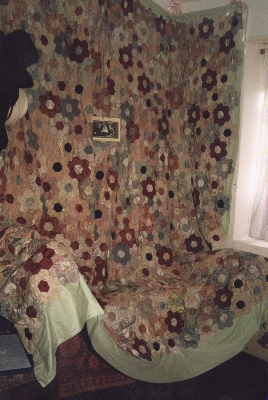Quilt No.693RA - Rhonda Allardice

3300 x 2400mm
This hexagon quilt was made by Mrs. Florence Gertrude Awyun (born Taylor) in Footscray Melbourne c.1938. It then passed to Rita Bowe, Florence's daughter and now belongs to Rhonda Allardice, Florence's grand-daughter. Florence used the quilt for approximately 35 years on her bed. It was the displayed for 8 years at Historic Bowe's Cottage, Maldon, Vic and is now on display at the Milliner's cottage, Port Fairy.
"The Story of the Quilt
It's maker: Florence Gertrude Awyun (nee Taylor)
Born 30th April 1891 - Snapper Point, Mornington, Victoria. Father's occupation - Brickmaker
1900 - Family shifted to Clifton Springs, near Drysdale, Victoria. Father's occupation - Fisherman. Florence worked as a domestic maid.
1905 - In Queenscliffe at a Doctor's Home. At the Federal Hotel, Melbourne (where she was exposed to the elegance of the upper class)
1909 - At Mac's hotel, Portland where she met Thomas Awyun (who cleaned Patron's boots).
1911 - Florence and Thomas went to Broken Hill. They married - Thomas was employed as a miner. They lived in a relocated corrugated iron home - Florence talked later in life of the heat during this time and how she hosed the house down at night time. Daughter Rita born 1913.
1915 January 1st - Florence and Rita were passengers on the 'Picnic Train' to Silverton. It became the scene of the only enemy attack on Australian soil during World War 1 - by 2 Turkish men. During the 3 hour battle 4 people were killed and 7 injured. There were 1200 passengers on the train, mainly women and children. (Florence talked about this often later in her liofe - very traumatic.)
1916 - The family shifted to Footscray where Thomas worked at The Maize Products on the Maribyrnong River. They had 2 children now. Rita and a son Jack.
1917 - Third son, Leslie born.
1918 - Son Jack died of diphtheria whilst holidaying at his Grandparents home in Clifton Springs. He was aged 4.
1914 - Son Robert born.
1919, 1930s - "Depression" years. Thomas was unemployed for 4 years. They took in a border who paid 12/6 a week - it covered the Mortgage repayments and Florence was an excellent homemaker who 'made do' - growing vegetables, sewing, crocheting, tatting etc. The quilt was made during the late 1920s using upholstery fabrics - Robert was an apprentice upholsterer who worked on high quality furniture 'the other side of Melbourne' at a company called Branchflowers. It took years to complete the quilt and was used on her bed until she died in 1975. Each year Florence displayed this quilt at Footscray Hospitals Annual Fete. Florence was awarded a Life Governor's Certificate for her charity work for the hospital.
1963 - After nursing Thomas through a very long illness he died. Florence herself suffered for a number of years as a result of this time.
1975 - Florence, still living in Footscray, took ill suddenly. When the family tried to have her admitted to Footscray Hospital for care - she was refused entry because of her age (over 80 policy at the time). (The family were devestated - upset when amongst her items they found 'The Life Goveernor's certificate' - all the work she had done and they refused to care for her.)
Florence passed away 1 week later in Werribee Hospital. Died - 19th May 1975 - Aged 84 years.
Florence was a gentle lady, an excellent homemaker (who often submitted entries scones, cakes, to the Royal Melbourne Show - collecting numerous prizes) caring Mother and Grandmother - who loved to be elegantly groomed - especially church days."
[Rhonda Allardice 1999]
Related Quilts:
1500 x 1040mm
935 x 635mm
1800 x 1630mm
1750 x 1100mm
2045 x 1940mm






